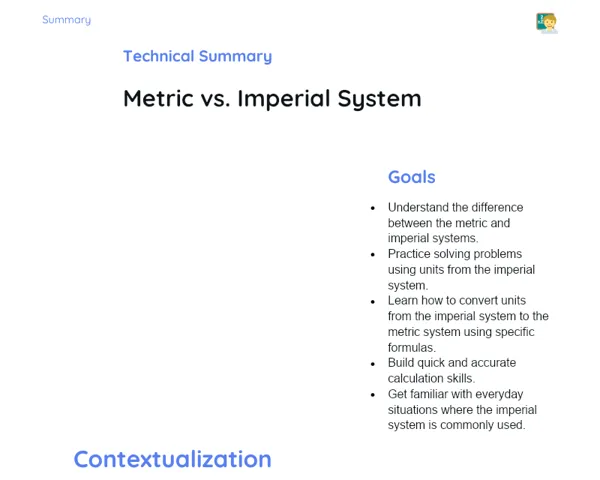Summary Tradisional | Angles: Vertically Opposite Angles
Contextualization
Angles form the very backbone of geometry and are seen in numerous everyday scenarios. Whether it’s in building construction, designing everyday objects or even observing natural patterns, angles play a crucial role. In particular, vertically opposite angles are interesting due to their unique property of always being equal in measure.
This concept is especially useful in areas like civil engineering. Take bridge construction as an example – engineers often rely on the property of vertically opposite angles to ensure the structural integrity of a bridge. Thus, a sound understanding and precise application of this property not only aids in solving mathematical problems but also enhances the safety and effectiveness of various practical projects.
To Remember!
Definition of Vertically Opposite Angles
When two straight lines cross each other, they form two pairs of vertically opposite angles. These angles share the same vertex and have sides that are opposite rays. This naturally ensures that the vertically opposite angles are equal in measure.
The concept of congruence here means that if one angle is, say, 40º then the angle directly opposite to it will also be 40º. This is a fundamental idea in geometry and it applies not only in theoretical problems but also in practical fields like engineering and design.
-
Vertically opposite angles share the same vertex.
-
Their sides are opposite rays.
-
Thus, these angles always turn out to be equal.
Fundamental Property
The key characteristic of vertically opposite angles is indeed their equality. That means, no matter what the values of the angles, if they are vertically opposite, they will always measure the same. This can be easily proved using basic geometric principles, such as the fact that the sum of all angles around a point is 360º.
Think of it like this: when two lines intersect, they create four angles which together add up to 360º. Each pair of vertically opposite angles then accounts for half of that sum, i.e. 180º. Owing to this symmetrical split, the angles must be equal.
This property finds great significance in practical settings such as construction, where ensuring that angles are accurately equal is essential for the stability of any structure.
-
Vertically opposite angles are congruent.
-
The sum of angles around any point is 360º.
-
Each pair of vertically opposite angles adds up to 180º.
Visual Demonstration
One of the best ways to grasp the concept of vertically opposite angles is through a visual demonstration. Using a whiteboard or a projector, draw two intersecting lines to form four angles. Ask students to identify the pairs of vertically opposite angles and measure them.
It is important to use accurate tools, like a protractor, so that the measurements are precise. This allows students to clearly observe the equality of the vertically opposite angles. A mix of visual aids with numerical examples—for instance, showing that if one angle is 50º, the opposite angle is also 50º—helps in cementing the theoretical concepts through practical observation.
-
Visual aids greatly help in understanding the concept.
-
Precise tools such as protractors should be used.
-
Combine visuals with numerical examples for better clarity.
Application in Mathematical Problems
Vertically opposite angles are often used in solving various mathematical problems. When the measurement of one angle is provided, it is easy to determine the measure of its vertically opposite counterpart since they are equal.
For example, if one angle is given as 70º, then its vertically opposite angle is automatically 70º. This principle simplifies calculations in geometry. It also becomes very handy when dealing with algebraic expressions. For instance, if one angle is expressed as '2x' and the other as 'x + 40º', the fact that these angles are equal leads to a simple equation: 2x = x + 40º. Solving this gives the value of x and thereby the measures of the angles.
-
Problems often use the property of vertically opposite angles.
-
Keep in mind that these angles are equal.
-
Algebra can be used to solve for unknown angle measures.
Key Terms
-
Angle: The space formed between two rays sharing a common origin.
-
Vertex: The common point where two lines or segments meet.
-
Congruence: A property indicating that two angles or figures are identical in shape and size.
-
Algebraic Expressions: Representations that use symbols, typically letters, to stand in for numbers in mathematical expressions.
-
Symmetry: A feature of the object where it remains unchanged under certain transformations.
Important Conclusions
In this lesson, we delved into the definition and importance of vertically opposite angles. When two lines intersect, they form pairs of angles sharing the same vertex, and these angles are always equal. This simple yet powerful property helps in solving many geometric problems and has significant applications in practical areas like civil engineering, where the precision of angles is critical for safety.
Through visual demonstrations and practical numerical examples, we reinforced how understanding this property is not just theoretical but also very useful in real-life scenarios. Additionally, we explored how to solve problems involving algebraic expressions and equate them using the principle of vertically opposite angles, thereby building a strong foundation for tackling more complex geometry challenges.
Recognising the significance of vertically opposite angles is a powerful tool in mathematics. It simplifies many computations and helps students identify patterns in everyday structures, making it a valuable topic in both academic and practical contexts.
Study Tips
-
Regularly revise the concept of vertically opposite angles to strengthen your understanding.
-
Practice by solving a variety of problems, including those that involve both numerical and algebraic representations.
-
Use diagrams and visual aids to get a clearer picture of how these angles relate to each other.



